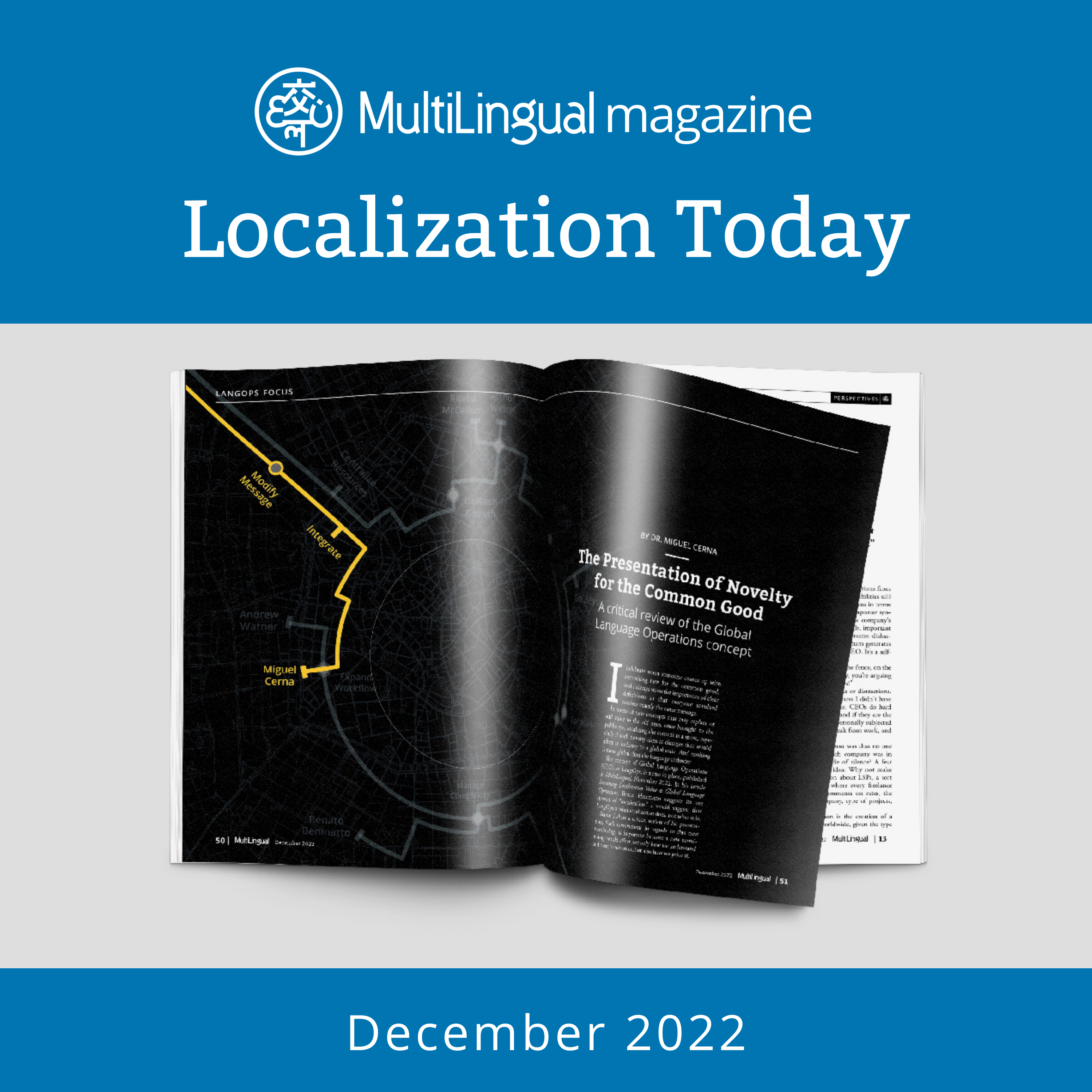Episode Transcript
[00:00:06] Speaker A: This is localization today, a podcast from multilingual media covering the most relevant daily news in the language industry.
[00:00:15] Speaker B: Dashing off a letter by Tim Brooks you may not know this, my linguistic friends, but we're undergoing a linguistic train wreck. Are, I mean that more literally than you might think.
[00:00:27] Speaker C: You know how when a train derails.
[00:00:29] Speaker B: At speed, the carriages or cars remain coupled for an instant, losing their clean.
[00:00:34] Speaker C: Straight ahead line and concertinaring and zigzagging.
[00:00:37] Speaker B: Against each other before breaking into smaller groups?
[00:00:40] Speaker C: That's the image I have in mind.
[00:00:42] Speaker B: Linguistically, every day, all over the Latinosphere.
[00:00:45] Speaker C: Regions using the Latin Alphabet. It's a train wreck, not of spoken.
[00:00:50] Speaker B: Language, but of writing.
[00:00:51] Speaker C: And it's happening because we're at a specific point in the history of writing.
[00:00:56] Speaker B: And especially of cursive writing. Here's the strange thing about cursive. Most scripts don't use it, that flowing.
[00:01:03] Speaker C: Letter to letter line that those of.
[00:01:05] Speaker B: My generation were taught, often with threats, in elementary school. Most cultures don't do that.
[00:01:11] Speaker C: Their writing consists of individual letters without.
[00:01:14] Speaker B: Ligatures, as if letters were, say, numbers.
[00:01:17] Speaker C: And the reason I bring up this.
[00:01:18] Speaker B: Point in history is, of course, because.
[00:01:21] Speaker C: Dwindling numbers in the western world write incursive. Most people under 30 essentially print their letters.
[00:01:28] Speaker B: Even those who, like me, were taught cursive.
[00:01:31] Speaker C: No longer use formal cursive for every.
[00:01:33] Speaker B: Kind of writing all the time.
The question is, what happens when you want to write quickly? If you're in a hurry printing out individual letters, noncursive letters without connecting ligatures gets clumsy.
[00:01:47] Speaker C: Cursive makes more sense.
[00:01:48] Speaker B: The faster you try to write, the.
[00:01:50] Speaker C: Less sense it makes to lift the.
[00:01:52] Speaker B: Pen, to interrupt that lateral rush across the page. But if you never learned cursive script.
[00:01:58] Speaker C: And you try to write quickly in.
[00:01:59] Speaker B: An involuntary cursive, what back in elementary.
[00:02:02] Speaker C: School we called joined upwriting.
[00:02:04] Speaker B: The result is that train wreck. Thus I offer you two little words.
[00:02:09] Speaker C: That illustrate the non cursive cursive crisis.
[00:02:12] Speaker B: The downfall of writing as a hasty manual act.
[00:02:15] Speaker C: Here's the context. Every time I sell a copy of.
[00:02:18] Speaker B: One of my books, I sign it.
[00:02:20] Speaker C: Before I get to my signature, though in most cases I write an apparently.
[00:02:24] Speaker B: Simple two word phrase, best wishes. Trust me, when I open the front cover of the book to sign it, that sentiment is genuine.
[00:02:33] Speaker C: I have not sold enough books in.
[00:02:35] Speaker B: My life to take a single sale for granted.
[00:02:38] Speaker C: So as my hand heads towards the.
[00:02:40] Speaker B: Page, I have the best intention of.
[00:02:42] Speaker C: Showing the buyer how grateful I am, by the way, that I write this dedication on the title page.
[00:02:47] Speaker B: Immediately, though, something weird, and I think important, happens to those good intentions and.
[00:02:53] Speaker C: To my hand, I almost never continue.
[00:02:55] Speaker B: In that calm, intentional spirit of gratitude. Instead, my mind is seized with this.
[00:03:01] Speaker C: Irrational and baseless belief that I can.
[00:03:03] Speaker B: Sign those two words. That is, I can write those two.
[00:03:07] Speaker C: Words as fluently as and as rapidly.
[00:03:09] Speaker B: As I sign my signature, as if the whole thing, greeting and signature, could be just a single flourish. At first, it seems possible the initial B is big, bold, and declarative. It's the headline, the marquee, and easy to form of a unit. I feel no obligation to make it.
[00:03:27] Speaker C: Connect to whatever comes next. Consequently, it's often the only decipherable letter.
[00:03:32] Speaker B: In the entire phrase.
[00:03:34] Speaker C: Next is also something I form with.
[00:03:36] Speaker B: Relish, the E, but in my case a Greek e. I love that letter, partly because it's somewhat unusual and partly.
[00:03:44] Speaker C: Because I adopted it in high school. It stands alone, retro on a millennial scale, having never been a part of angloamerican cursive. That's one reason why cursive began to decline roughly half a century ago.
[00:03:57] Speaker B: The attraction of cursive writing is that it creates such a lovely musical impression. The individual letters, though, get subsumed into that impression. Once we lose the ligatures, the individual.
[00:04:09] Speaker C: Letters acquire their own particular shapes and statures. Maybe this change we're seeing from unified.
[00:04:14] Speaker B: To individual letters is part of a broader social change, a desire to stand.
[00:04:19] Speaker C: Out rather than to make an impression.
[00:04:21] Speaker B: More humbly as part of a crowd. The trouble is, precisely because the greek.
[00:04:26] Speaker C: E is not a cursive letter, this is the first tremor in the motion.
[00:04:30] Speaker B: That indicates the coming train wreck. It doesn't join to the B before it.
[00:04:34] Speaker C: And it's not like the standard loopy.
[00:04:36] Speaker B: That, like a slinky, can be repeated countless times without the pen leaving the page. Oh. Conversely, the greek E middle arm is.
[00:04:45] Speaker C: A nice, inviting horizontal, moving from left.
[00:04:48] Speaker B: To right, ready for the next letter, a natural, artificial ligature to the s.
[00:04:53] Speaker C: The only problem with that is I'm.
[00:04:55] Speaker B: Already getting impatient, wanting to move on.
[00:04:57] Speaker C: To the next letter. Consequently, S's last curve just dives down and makes a half hearted attempt to recurve before shooting up toward the top.
[00:05:06] Speaker B: Of the T. The T likewise has its agenda, and I have my agenda. The downward stroke is fine, except that.
[00:05:14] Speaker C: Already I'm thinking I have to get up to the horizontal stroke. And so, instead of completing a nice.
[00:05:19] Speaker B: Hockey stick shaped curve, the bottom of.
[00:05:21] Speaker C: The t is truncated and shoots up to the midpoint prematurely, leaving something that.
[00:05:26] Speaker B: Looks like a badly formed f. Then.
[00:05:28] Speaker C: We come to the space between the.
[00:05:30] Speaker B: Two words, the negative white space that will paradoxically unite best with wishes. In the act of writing, the space is not only a relief but also.
[00:05:40] Speaker C: An opportunity to reset. So I begin the W at exactly.
[00:05:44] Speaker B: The right height, technically the x height.
[00:05:47] Speaker C: Based on the admittedly erratic letters of best.
[00:05:50] Speaker B: The first letter is once again the best part of the word, though in.
[00:05:54] Speaker C: This case my haste is already catching up with me. And the second descending loop of the W is not the same depth as.
[00:06:01] Speaker B: The first, bracing itself for the leap up and across to the start of the I. And here I find myself remembering my father signing a check in his cooperative.
[00:06:10] Speaker C: Savings bank book half a century ago. My father's handwriting was emphatic and expressive.
[00:06:16] Speaker B: And, unlike my mother's, had no investment.
[00:06:18] Speaker C: Or interest in coherence or consistency. He wrote in a series of twists.
[00:06:23] Speaker B: And flicks, letter clusters, word fragments that each had its own connective logic but.
[00:06:28] Speaker C: Bore only a neighborly relationship to the.
[00:06:31] Speaker B: Rest of the word.
[00:06:32] Speaker C: I remember him writing the connected double.
[00:06:34] Speaker B: O of Brooks, the two o's height inconsistent, then pausing a fraction, the pen leaving the page before moving to the k, which he gave its full graphic.
[00:06:43] Speaker C: Value by not connecting it to the.
[00:06:45] Speaker B: Letter on either side, and then the final es, a closure, a caboose.
[00:06:51] Speaker C: We don't seem to have english terms that describe this process, or these fascinating.
[00:06:55] Speaker B: Little letter clusters or verbal subunits. Scribe beams. We all use them, but nobody notices.
[00:07:03] Speaker C: Nor do we have eager graduate students going after naughty essay questions like is writing fundamentally continuous or discontinuous?
[00:07:11] Speaker B: Writing consists of symbols, and a symbol may be clear, distinctive, and delightful and.
[00:07:16] Speaker C: Yet unfriendly to the hand and at best on nodding terms with its neighbors. It's increasingly common, as the world's typographers create fonts that look great but don't join up.
[00:07:27] Speaker B: Back at the page, the top of.
[00:07:28] Speaker C: The w swings over to the I.
[00:07:30] Speaker B: And then things collapse. The eye comes down. But if it were a cursive eye, it would come down, swoop around, and.
[00:07:38] Speaker C: Head up to the top of the.
[00:07:39] Speaker B: S. All would be well. Instead, in my hands, this linkage is a mess. The eye comes down, but then where does it go?
[00:07:47] Speaker C: It has to go up and dot itself, as if grabbing the wallet it.
[00:07:51] Speaker B: Left on the kitchen counter. The S starts with a dot above.
[00:07:55] Speaker C: The I and heads off in the.
[00:07:56] Speaker B: Right direction, but then everything crumbles like a badly damaged pretzel.
[00:08:00] Speaker C: The pen abandons the s and pants.
[00:08:03] Speaker B: Uphill to start the h. Here, at least, we have a possible downstroke. The problem comes afterward, where the line.
[00:08:10] Speaker C: Should retrace its steps back upwards for.
[00:08:12] Speaker B: A little while and then curve over to the right.
[00:08:15] Speaker C: But there's no retracing if you're in a hurry.
[00:08:18] Speaker B: Instead, what happens?
[00:08:20] Speaker C: It comes down and then loops around.
[00:08:22] Speaker B: And shoots up again, more like a B.
[00:08:24] Speaker C: And already my hand is trying to.
[00:08:26] Speaker B: Sprint to the finish to kill this thing off. But again, a greek e is not a cursive letter. Nothing for it. We have to leave the page, leave that ghastly four letter carnage for dead.
[00:08:37] Speaker C: And at least come up with something.
[00:08:39] Speaker B: For the E and the S. At first, there is just the possibility of grace.
[00:08:43] Speaker C: Because the C curve of the greek.
[00:08:45] Speaker B: E is a lovely swoosh, full of.
[00:08:47] Speaker C: Acceleration and play, married perfectly to the.
[00:08:50] Speaker B: Turn of wrist and elbow.
[00:08:52] Speaker C: And the horizontal starts on the left with a flourish. And curves up towards the s. As.
[00:08:57] Speaker B: If to say, yes, we can be distinct letters, but we can still also unite. We can join hands. There will be a dance.
[00:09:04] Speaker C: There will be grace.
[00:09:06] Speaker B: But again, the S is a problem. A letter utterly inimical to haste.
[00:09:10] Speaker C: It is unsafe to operate an S at speed.
[00:09:13] Speaker B: Its hairpin curves demand attentive driving. And worst of all, the S is a lousy final letter.
[00:09:20] Speaker C: It essentially turns itself inside out and.
[00:09:22] Speaker B: Then heads backwards like an in growing toenail. It's a design flaw.
[00:09:27] Speaker C: How can you end a word with a letter whose final motion is backwards and inwards? In the mongolian script, every letter has a distinct form. For when it appears at the end of the word. A form much more elaborate and final than the form it adopts when it.
[00:09:41] Speaker B: Sits in the middle of the word.
[00:09:43] Speaker C: Mongolian finals are the conception of a calligraphic culture.
[00:09:47] Speaker B: Everyone swooping left or right, signing off.
[00:09:50] Speaker C: Turning each word into a wrought and.
[00:09:52] Speaker B: Finished filigree of script. In short, what I write is a.
[00:09:56] Speaker C: Demonstration of anything but best wishes. It's a demonstration of confusion and conflict, of haste and momentary demonstrations of the desire for beauty.
[00:10:05] Speaker B: That are pulled apart like a great.
[00:10:07] Speaker C: Jungle cat running through a fawn.
[00:10:09] Speaker B: Boosh.
[00:10:09] Speaker C: And the reason why the end of.
[00:10:11] Speaker B: Best wishes is such a catastrophe.
[00:10:13] Speaker C: Is that instinctively I know I'm heading for the one part of this exercise.
[00:10:17] Speaker B: That I know how to do well.
[00:10:19] Speaker C: Which is the signature. A signature is a fascinating piece of writing. It's the only piece of writing most.
[00:10:25] Speaker B: Of us practice by hand, perhaps even on a daily basis, until it's laid down in our muscle memory like a carpet. Moreover, it doesn't matter if nobody can read it.
[00:10:35] Speaker C: A signature has nothing to do with clarity or even with the constituent symbols.
[00:10:40] Speaker B: Of one's script, a signature is built.
[00:10:42] Speaker C: For comfort and speed.
[00:10:44] Speaker B: I'm proud of my signature.
[00:10:46] Speaker C: It fits within the flexible bounds of what we view as signatures, and it's like nobody else's. At least the t is strong and clear and proud. The rest a series of obedient and.
[00:10:56] Speaker B: Faithful echoes, like the train of a wedding dress on a windy day.
[00:11:01] Speaker C: For somebody who believes so strongly in.
[00:11:03] Speaker B: The importance of handwriting and in writing as a manual art, I'm ashamed of my own writing.
[00:11:09] Speaker C: There are times when I take the.
[00:11:10] Speaker B: Calligraphy pen and work a graceful, clear.
[00:11:13] Speaker C: Word or a letter. There are times I use the calligraphy pen to write an address on an outgoing package. The only problem is that the more pleased I am with my calligraphic handwriting.
[00:11:23] Speaker B: The more likely Alyssa, the counter clerk, is to say, what's that word here? And is that a six or an eight?
[00:11:30] Speaker C: Writing is the creation of specialists and leisure. It is in harmonious with haste and mechanization.
[00:11:37] Speaker B: It's hardly surprising, then, that we've invented.
[00:11:40] Speaker C: Devices that allow my daughter's generation to.
[00:11:42] Speaker B: Write at superhuman speed with their thumbs.
[00:11:47] Speaker C: This article was written by Tim Brooks, the founder of the Endangered Alphabets Project.
[00:11:52] Speaker B: And author of Endangered Alphabets. His current project is to create a.
[00:11:57] Speaker C: Red list of the world's writing systems, identifying every script currently at use in.
[00:12:02] Speaker B: The world and assessing its degree of health or vulnerability.
Originally published in multilingual magazine, issue 225, March 7, 2024.
[00:12:14] Speaker A: Thank you for listening to localization today. To subscribe to multilingual magazine, go to multilingual.com.
Subscribe.


